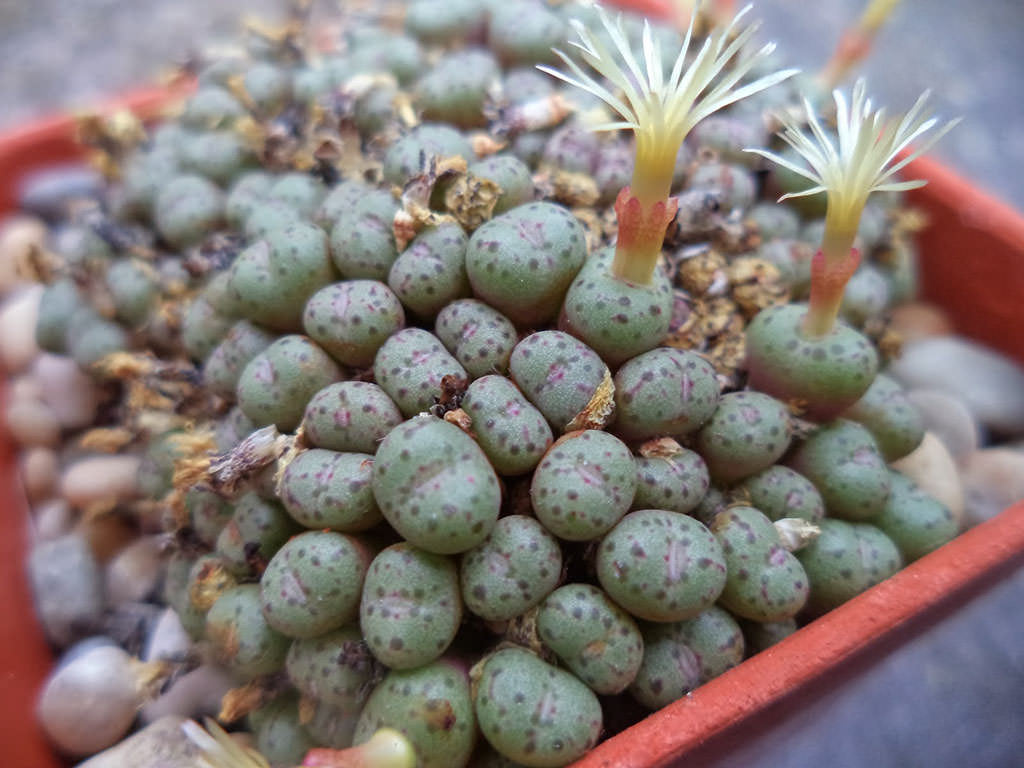Scientific Name
Conophytum uviforme (Haw.) N.E.Br.
Synonym(s)
Conophytum clarum, Conophytum colorans, Conophytum framesii, Conophytum franciscii, Conophytum hillii, Conophytum julii, Conophytum litorale, Conophytum meleagris, Conophytum pardivisum, Conophytum praeparvum var. roseum, Conophytum prolongatum, Conophytum rooipanense, Conophytum stipitatum, Conophytum uviforme f. framesii, Conophytum uviforme f. meleagris, Conophytum uviforme subsp. uviforme, Conophytum uviforme var. clarum, Conophytum uviforme var. litorale, Conophytum uviforme var. occultum, Conophytum vanrhynsdorpense, Mesembryanthemum uviforme
Scientific Classification
Family: Aizoaceae
Subfamily: Ruschioideae
Tribe: Ruschieae
Genus: Conophytum
Origin
This species is native to South Africa (Western Cape and Northern Cape), where it grows on quartzite or calcrete patches, sandstone, or limestone ridges.
Description
Conophytum uviforme is a dwarf succulent that usually grows in clusters of many bodies, forming a compact dome up to 8 inches (20 cm) in diameter. The bodies are globose to inversely pear-shaped and composed of two fleshy, almost entirely fused leaves. They are up to 1 inch (2.5 cm) tall with an equal diameter. The epidermis is greyish green to ochre or reddish, usually spotted or streaked. The markings are brownish-grey, often prominent and shining. Flowers are nocturnal, have white to pale yellow or amber petals, often with red tips, and appear in fall. Fruits are 5- to 6-locular capsules.
Etymology
The specific epithet "uviforme (oo-vee-FOR-mee)" means "grape-shaped" and refers to the bodies of the species. It is a compound of two Latin nouns, "uva," meaning "grape," and "forma," meaning "form" or "figure, shape, appearance."

How to Grow and Care for Conophytum uviforme
Light: This succulent needs bright light but does not like too much direct sun. To avoid sunburn, place your C. uviforme in a position to receive a few hours of full sun in cooler periods of the day. The plant stretch if it needs more light.
Soil: C. uviforme thrives best in porous soil mixes that allow water to drain away quickly. Use a commercial potting mix specially designed for growing succulents or make your own.
Hardiness: High temperatures are not a problem, but this plant can be damaged when the temperature goes below freezing. C. uviforme can withstand temperatures as low as 30 to 50 °F (-1.1 to 10 °C), USDA hardiness zones 10a to 11b.
Watering: C. uviforme requires little or no water when it goes dormant in the spring. In the fall, when it begins growing, it is safe to water deeply, allowing the soil to dry before watering again. During active growth, your plant needs water if leaves start to wrinkle.
Fertilizing: This small succulent is a light feeder and does not need fertilizer if it is repotted every two years.
Repotting: The best time to repot C. uviforme is at the beginning of the period of active growth, but repotting can be done at almost any time while the plant is actively growing.
Propagation: Like all Conophytums, this plant is easily propagated by division. It can also be grown from seeds. The best time to divide C. uviforme is in late summer or early fall, before it begins to break dormancy or after it has flowered. Sow the seeds in fall in a pot with a well-drained soil mix.
Learn more at How to Grow and Care for Conophytum.
Toxicity of Conophytum uviforme
C. uviforme is non-toxic and safe to grow around children and pets.
Links
- Back to genus Conophytum
- Succupedia: Browse succulents by Scientific Name, Common Name, Genus, Family, USDA Hardiness Zone, Origin, or cacti by Genus
Photo Gallery
Click on a photo to see a larger version.


